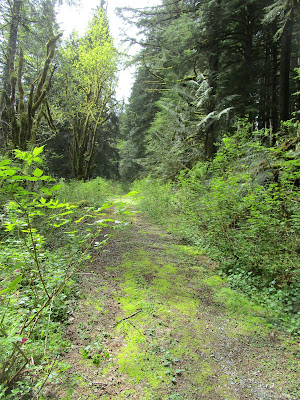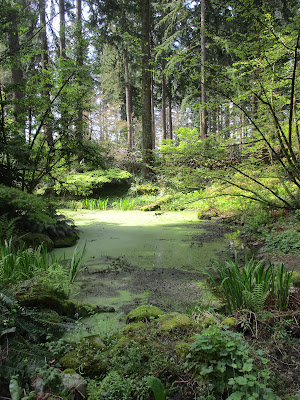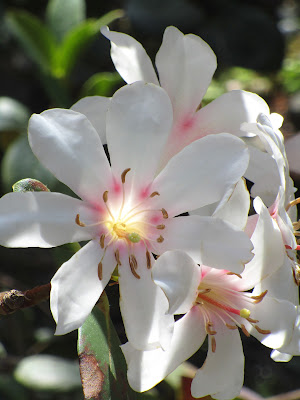The beginning of the Taylor River trail is the remains of an old logging road. It is fairly wide but extremely rocky as can be seen in the picture. The trailhead is a short, rough drive with lots of pot holes, from the large Garfield Ledges trailhead.
One day, three short hikes: Taylor River, Quartz Creek, and the Taylor River Connector to Middle Fork Snoqualmie. The Forest Service Pass is required. All three of these trails are close to one another. We parked at the Taylor River trailhead for the first two and moved the car down to the Garfield Ledges trailhead parking area for the Connector trail. There is a newer double outhouse privy at Garfield Ledges trailhead and a newer single outhouse at the Taylor River trailhead.
Note: Young children could easily do the short, level Connector trail which goes through woods and also has areas near the river with benches here and there that were carved out of downed trees. The Quartz Creek trail is through woods but perhaps not as interesting. Since it is a continuous up it might be tiring for young kids. The Taylor River trail is extremely rocky and has creek crossings that might pose problems for younger children.
This day started out with a plan to hike along the Taylor River for a couple of hours for a 4.5 or 5-mile RT with very little elevation gain, cross a few creeks, and see waterfalls. We started out with hope but ended up only going part way, stopped by a creek that was too deep for us to cross without gators, fishing boots or water socks. Younger hikers could and did cross, either by wading, or hoping rock to rock. The water was running fast and cold over the rocks. Our balance and rock hopping skills are not as they once were.
Our turn around point on the Taylor River Trail. It doesn't look too bad at first glance. Bob walked out a little way and tested the depth with his foot and a trekking pole. The water at the edge of the other side was deeper than the tops of our boots. There were no good stable rocks to use as stepping stones.
After much agonizing and analyzing the situation, we made the decision to backtrack and try the adjacent trail, Quartz Creek.
The Quartz Creek trail is a steady climb up, and up, eventually reaching Blethen Lake. The second half of the trail is a dotted line on the map = unimproved. The lake was much farther than we wanted to go but we gained about 400 ft elevation before turning around and heading back.
Quartz Creek trail is also an old logging road; however, it started out like this, broad and easy walking instead of rough and rocky.
One small, pretty waterfall on the Quartz Creek trail
That did not seem like quite enough for one day so we took the Middle Fork connector trail from Garfield Ledges trailhead to the Middle Fork trailhead and back to Garfield where we had left the car.
Near the Taylor River trailhead, Bob standing by trees covered in moss
Trillium
Bleeding heart
Salmon berry
Yellow Stream Violets
Service berry aka Saskatoon
Bench and chair cut from downed trees along Taylor River Connector trail
The day ended with lunch in the car and a stop at Boehm’s Candy in Issaquah for much needed chocolate. Total hiking distance for the day about 4 miles.
Count for the day, 5 hikers and two 12-year old Bassett hounds wearing GPS collars with antennae.
I talked with the owner of the dogs and asked about the collars. He had leashes but he was letting them walk leash free. He told me the dogs were old, slow, and sometimes would wander off. Usually they would go together but once, before he had the collars, they separated and he couldn't find one of them. He took the other dog back to the last place he had seen the dogs together and told her to find her sister. Sure enough she sniffed around and trotted off successfully finding the other dog after a while. To avoid a potential lost dog scenario the owner had found and read an article about the collars, ordered two, and now they both wear the collars whenever they are out walking. The dogs were very well behaved nice dogs and that equals a good owner in my opinion.

































































